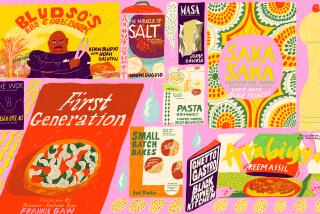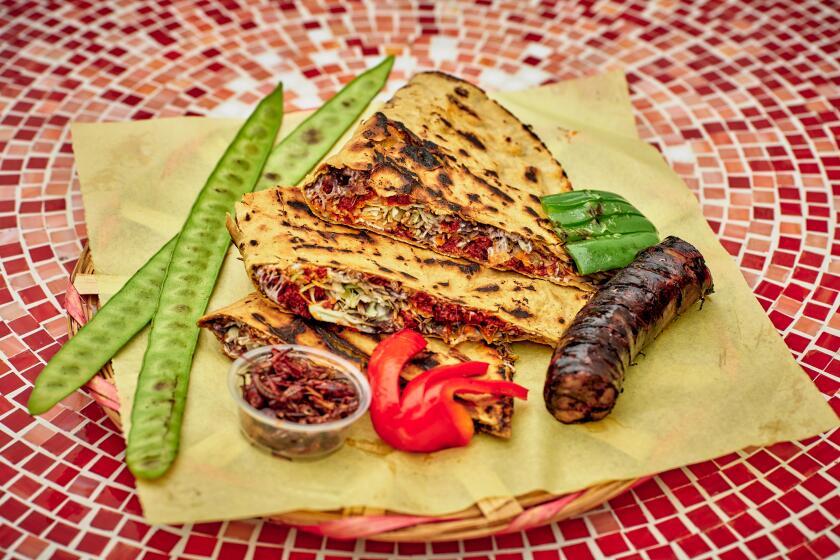Recipes From the Dutch Oven Cooking Contest : Cookware: Cast-iron pots and caldrons reached apex of popularity during settlement of the West.
Inspired by new, exotic ingredients and a need for simple, hearty fare, the people who settled this country developed a unique style of cooking as they moved ever westward.
These vigorous folk moved West for myriad reasons: to conquer untamed territory, to seek their fortunes in gold, to farm, to herd cattle or sheep. Linking them to one another--and to generations before and to come--was the longing for adventure. Theirs was a rugged lifestyle that led to distinctly Western traditions and food ways. Cooking was all the more extraordinary because there were no stoves, only campfires and cast iron.
Generation upon generation crossed the Rockies, the Sierra Nevadas and the Cascades. First to come were the Spanish conquistadors. Then came trappers and fur traders, gold miners and cattle ranchers. Basque sheepherders followed, attracted by the similarity of this region to their homeland, the mountains between France and Spain. Finally, farmers arrived, bringing families and a new civility.
Piled into their small wagons were a few pieces of spare clothing, guns and ammunition, and a small treasure or two to remind them of the homes they’d left behind. These were tucked around their staples: sourdough, flour, coffee, tinned tomatoes, salt pork, dried beans, salt, sugar, molasses and lard. Hanging from the back of the carts--the ubiquitous sign of the West--were their cast-iron kettles.
As they struggled to make the wild land their own, they learned secrets of survival from Native Americans. Arid expanses were whipped relentlessly by mighty winds, yet the settlers discovered that the soil, so barren in appearance, yielded edible wild plants and berries.
They also learned new methods of growing foods familiar to them. With these ingredients, they made the boiled meals typical of the Native American diet--stews and cornmeal puddings, succotash and hominy--all of which adapted well to their cast-iron cookware.
As soon as the winter snows melted, food crops were planted and the hunting became bountiful. There were buffalo, antelope, wild turkey, rattlesnake, bear, elk, moose and fish. Western cooks experimented until they found ways to combine new foods with their staples in dishes that reminded them of the foods they’d known before: spicy Spanish stews, French pots-au-feu, English-roasted meats and sweets from wild berries and nuts.
With practice, the settlers found they could prepare nearly any dish for which they hungered. In the heavy vessels they could fry, bake, boil or poach their food. They baked sourdough bread, biscuits and hot cakes. For times of feasting and celebration, they made fruit pastries, layer cakes and doughnuts.
All were made in the iron caldrons. And as the decades passed, there remained little ethnic distinction in their foods because settlers had shared, adapted and altered their recipes so often.
Though cast-iron cookware reached a pinnacle of popularity during the settlement of the West, its history goes back centuries. As early as 1500, in fact, cast iron was essential cooking equipment in Europe’s royal kitchens. Nearly 200 years later, ironware was in common use throughout Europe. English exporters were responsible for supplying most of the Old World and the American colonies with cast-iron kettles, pots, skillets and other cookware.
It is said that Columbus had cast-iron cookware on his ship when he discovered the New World. However, Paul Revere is credited with the design of the pot that became known as the Dutch oven. It had a flat lid with a turned-up lip to hold coals (to provide heat on top of a food, simulating an oven’s environment). The pot itself stood on three short legs so it could be settled evenly over a slow-burning fire.
The oven was named for 18th-Century itinerant peddlers--many of them of Dutch descent--who sold pots and pans from the backs of their wagons. These peddlers were eagerly awaited. Many households had several of their ovens in various sizes; not only could colonists use them for cooking and baking, they could make soap, boil laundry and dye fabrics in them.
Because Dutch ovens were virtually indestructible and infinitely versatile, they were considered essential survival equipment on almost every exploration into new territory. Camp cooks on cattle drives used them; Lewis and Clark carried cast-iron kettles on their 1804 expedition to the Pacific Northwest; and gold miners not only cooked dinner in their Dutch ovens, they used them to pan for gold.
Recently, new attention has been given to Dutch-oven cooking and the part it played in the settlement of the West. A longtime Dutch-oven cook in Logan, Utah, is responsible for at least some of the renewed interest. Dick Michaud, who wanted to share both his enthusiasm for this old-fashioned cooking and his love of the West’s history, helped establish a Dutch-oven cooking contest in his northern Utah community five years ago.
The contest, which runs in conjunction with the annual Festival of the American West at Utah State University, continues to attract more contestants each year. Cooks come from throughout the West to dig holes in the campus grounds, build slow-burning fires and create culinary delights of every description.
Here are some of Michaud’s favorite recipes, adapted for indoor cooking.
CORN BREAD
1 cup flour
1 cup yellow cornmeal
2 to 4 tablespoons sugar
1 tablespoon baking powder
1/2 teaspoon salt
2 eggs
1 cup milk
1/4 cup oil or shortening, melted
Line bottom of 10-inch Dutch oven with foil, bringing foil partway up sides. Grease well and set aside.
Stir together flour, cornmeal, sugar, baking powder and salt in mixing bowl. Beat together eggs, milk and oil in separate bowl. Add to flour mixture and stir just until batter is smooth. Do not overbeat.
Pour into prepared Dutch oven. Bake at 425 degrees 20 to 25 minutes or until golden brown. Makes 8 to 9 servings.
SON-OF-A-GUN STEW
1/2 pound bacon slices
2 pounds cubed beef stew meat
2 (32-ounce) cans whole tomatoes, cut up
2 medium onions, chopped
1/4 cup soy sauce
1/4 cup Worcestershire sauce
Hot pepper sauce
1 pound carrots, cut into 3/4-inch slices
2 pounds potatoes, peeled and cubed
2 green peppers, chopped
5 medium stalks celery, sliced
Cook bacon until crisp in 10- or 12-inch Dutch oven. Remove and drain on paper towels. Crumble bacon and set aside.
Drain all but 2 tablespoons bacon fat from Dutch oven and brown meat, half at time, over medium heat. Return all to oven. Add undrained tomatoes, half of bacon, onions, soy sauce, Worcestershire and several dashes hot pepper sauce. Bring to boil. Reduce heat and simmer, covered, 1 to 1 1/4 hours or until meat is nearly tender.
Add carrots, potatoes, green peppers and celery. Continue simmering, covered, 40 minutes longer or until meat and vegetables are tender. Skim off fat. Sprinkle reserved bacon over stew and serve. Makes 8 servings.
JOE FROGGERS
4 cups flour
1 1/2 teaspoons ground ginger
1/2 teaspoon ground cloves
1/2 teaspoon ground nutmeg
1/4 teaspoon ground allspice
1 1/2 teaspoons salt
2 tablespoons rum
1/3 cup water
1 cup dark molasses
1 teaspoon baking soda
1/2 cup butter or margarine
1 cup sugar
Stir together flour, ginger, cloves, nutmeg, allspice and salt. Combine rum and water in small bowl.
Stir together molasses and baking soda in separate bowl.
Cream together butter and sugar until fluffy. Beat in half of dry ingredients and half of rum water, then half of molasses mixture. Repeat. Cover and chill dough several hours or overnight.
On well-floured surface, roll dough 1/4-inch thick. Cut with 4-inch cookie cutter or 1-pound coffee can. Place cookies on greased baking sheets. Bake at 375 degrees 10 to 12 minutes. Let stand 2 to 3 minutes, then remove from sheets onto cooling racks. Makes 18 cookies.
SUCCOTASH
4 slices bacon
2 cups sliced okra
1 medium onion, chopped
3 cups fresh or frozen whole kernel corn
3 large tomatoes, peeled and chopped
1 medium green pepper, chopped
1 teaspoon sugar
Several dashes hot pepper sauce
1/2 teaspoon salt
1/4 teaspoon black pepper
1/3 cup snipped cilantro
Cook bacon in 10- or 12-inch Dutch oven until crisp. Remove bacon and drain on paper towels, reserving drippings in Dutch oven. Crumble bacon and set aside.
Add okra and onion to drippings and cook, stirring, 3 to 4 minutes or until tender-crisp. Add corn, tomatoes, green pepper, sugar, hot pepper sauce, salt and pepper. Simmer, covered, about 15 minutes or until vegetables are tender, stirring occasionally. Stir in cilantro and crumbled bacon. Makes 6 to 8 servings.
SWEET PEPPER-
STUFFED SALMON
1 (3- to 4-pound fresh or frozen) dressed salmon (head and tail removed), thawed
Salt, pepper
1 small onion, thinly sliced
1/2 lemon, thinly sliced
1 sweet red or green pepper, thinly sliced into rings
Freshly snipped parsley
6 ears corn, husked
2 tablespoons butter or margarine, melted
1 tablespoon lemon juice
1 cup water
Grated Parmesan cheese
Sprinkle inside of salmon with salt and pepper to taste. Stuff with onion and lemon slices, half of sweet pepper rings and parsley. Secure with wooden skewers, if necessary.
Arrange ears of corn in bottom of 12- to 14-inch Dutch oven. Combine melted butter and lemon juice and brush over salmon. Place salmon on top of corn. Arrange remaining pepper rings on top of salmon.
Add 1 cup water to Dutch oven and bring to boil. Reduce heat. Simmer, covered, about 50 minutes or until fish flakes easily with fork. (Add more water during cooking, if necessary.) Remove salmon and place on serving platter. Remove skewers. Sprinkle with cheese and serve with corn. Makes 6 servings.
For more information about the cooking contest that runs in conjunction with the Festival of the American West at Utah State University, or Dutch Ovens, contact Dick Michaud, International Dutch Oven Society, 1104 Thrushwood, Logan, Utah 84321, or telephone (602) 752-2631.
More to Read
Eat your way across L.A.
Get our weekly Tasting Notes newsletter for reviews, news and more.
You may occasionally receive promotional content from the Los Angeles Times.










